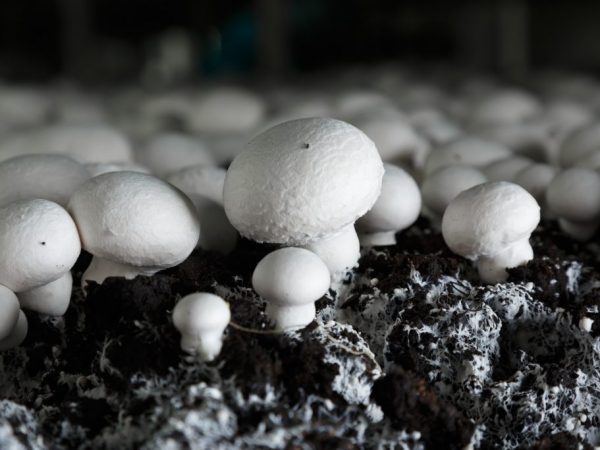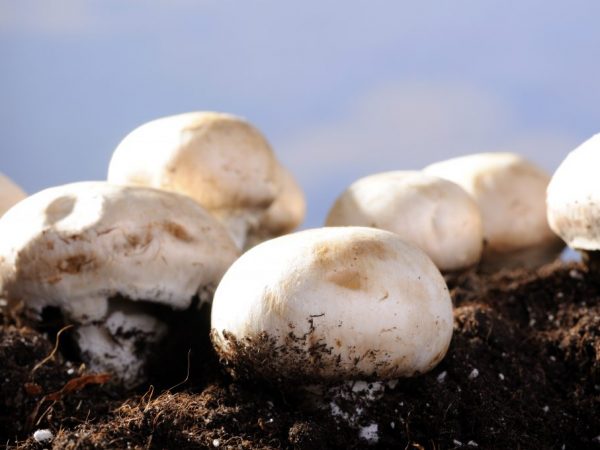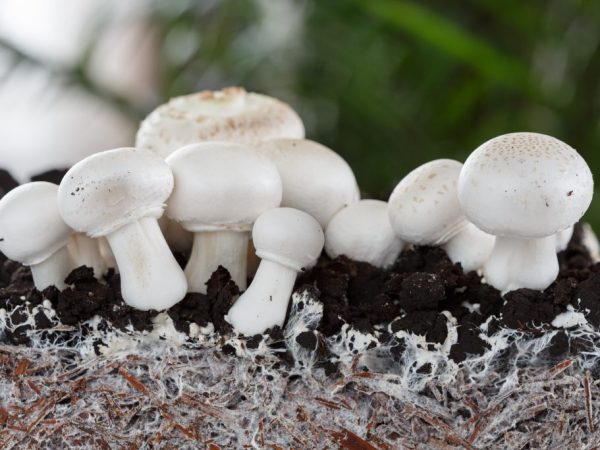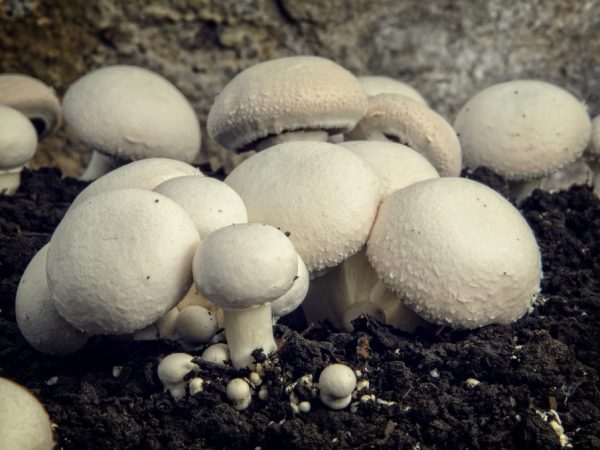Home cultivation of champignons
Mushroom growing is the fastest growing area of agriculture. The cultivation of champignons attracts the most attention to itself, since this product has a higher demand in the market compared to other mushrooms. It is also important that the culture lends itself to breeding at home.
- Description of champignons
- The benefits and harms of the product
- Industrial cultivation of mushrooms
- Benefits of growing mushrooms at home
- Growing in the basement
- Preparation of the culture medium
- Obtaining and using mycelium
- Growing in the garden and in the greenhouse
- Features of the care of the planted crop
- Growing mushrooms in the apartment (on the balcony)
- Conclusion

Home cultivation of champignons
Description of champignons
Champignons belong to lamellar mushrooms. Their cultivation began more than 300 years ago in Italy, and then in France (translated from French, "champihnon" - mushroom). In the middle of the seventeenth century, the mushroom culture was already quite widespread near Paris, as clearly stated in the “Guide to gardening” from 1652. There are several varieties of such a culture. Popularly, they are divided by the color of the cap into white, cream and brown. Cream (they are also royal) is artificially brought out in factories and farms. The rest of the species are found in nature.
In the scientific sense, mushrooms are divided into several groups according to the place of growth.
Mycologists distinguish 5 ecological groups of mushrooms according to their attachment to the substrate:
- Saprophytes growing only in the forest.
- Soil saprophytes, inhabitants of open spaces devoid of herbaceous cover.
- Humus saprophytes are herbophiles, found only in open spaces among the grass.
- Humus saprophytes, inhabitants of open spaces among the grass and in the forest.
- Desert species, partly halophytes, growing on saline soils.
Irina Selyutina (Biologist):
Saprophytes are called plants, fungi or microorganisms that feed on the substances of dead organisms (destroy them) and animal secretions, converting them in the process of their vital activity into inorganic and simplest organic compounds. Also, saprophytes are often called reducers and destructors.
Champignon is the most widespread mushroom in the world. Even children are familiar with the external features of the fruiting bodies of the fungus:
- the cap of the mushroom body has a dense structure, rounded, its diameter is 4-10 cm;
- the surface of the cap is covered with small scales;
- a lamellar hymenophore is located on the inner (lower) side of the cap;
- the leg is even, from 1 to 6 cm in height;
- the color of the flesh is white (a pink tint may be present).
In nature, culture reproduces in two ways: by spores, and by division of the fungal mycelium. The former is most often used to grow mushrooms on industrial farms. The second is for growing mushrooms at home, on a plot (in a vegetable garden), in a greenhouse, garage or in a basement.
The fungus is a saprotroph, therefore it loves fertile soil rich in humus. It also grows on anthills and tree bark. Most of them grow in the absence of vegetation.
The mushroom is versatile in culinary use.It is suitable both for mushroom dishes and as a component of any first and second courses. They are even used to make desserts.
The benefits and harms of the product
Champignon is not inferior in its useful properties to other varieties of mushrooms. It is rich in proteins, beneficial amino acids and carotenoids. The biochemical composition of the fruiting body includes hundreds of substances of organic and inorganic origin useful for the human body. Thus, champignon is characterized by the content of a large amount of vitamins (C, D, H, E, B, etc.), micro- and macroelements (for example, phosphorus, iodine, calcium and magnesium).
The mushrooms contain substances that are similar in action to antibiotics, so its use is widespread not only in cooking, but also in folk medicine. Experts believe that the use of mushrooms helps to destroy hundreds of species of bacteria, the most dangerous of which are Salmonella and Koch's bacillus.
Eating mushrooms has a positive effect on the intestinal flora and has a beneficial effect on the cardiovascular system. It also has other beneficial properties:
- improves appetite;
- slows down the aging process;
- removes radionuclides and toxins;
- counteracts inflammatory processes;
- has an antioxidant effect.
The fungus is harmless to humans. However, there are still contraindications for him. It should be used with caution:
- children under the age of 5;
- pregnant women and women during lactation;
- with acute diseases of the digestive system;
- harmful use of fruits with gout.
For your information. Due to the high content of folic acid in the pulp of the mushroom, champignons are contraindicated for cancer patients. This is due to the fact that excess folic acid can accelerate the growth and multiplication of tumor cells. For the same reason, people with this kind of problem should not eat leafy greens.
Industrial cultivation of mushrooms
Mushroom growing is a young branch of agriculture. They began to grow mushrooms on an industrial scale outside of Russia. On the shelves and counters of domestic stores, products from foreign manufacturers were most often found. Today we have learned to grow champignons too. There are factories and farms for the cultivation of myceliums in every region of the country.
Mycelium production (growing mushrooms at home in the basement) is a profitable business. Its profitability is higher than other areas of agricultural activity. With the correct organization of all conditions, you can get a crop all year round. Only from an area of 5 m² will it be possible to collect up to 200 kg of fruit bodies per year. All that is needed is to organize favorable conditions for the reproduction and development of fungi.

Provide mushrooms with optimal conditions for development
The very process of growing champignons is simple. The mycelium is kept in special boxes with a substrate, installed on racks, or grown in bags. The growth and development of culture depends on the availability and quality of ventilation equipment, thermoregulation and irrigation systems. There are also automated installations, the use of which practically excludes human labor in caring for the mycelium.
Benefits of growing mushrooms at home
If a person's goal is not to open his own mushroom growing enterprise, but he wants to breed a culture, it will not be difficult to grow mushrooms at home. The easiest way for beginners is to grow mushrooms in the house, on the windowsill of the balcony in their own apartment. The main advantage of such a mini-breeding is that you do not need to look for a room for growing mushrooms. A person can collect a bucket of tasty and healthy mushrooms without leaving home.
Having studied all the features of growing a culture, you can proceed to the next stage: create a mycelium in a personal plot, in a vegetable garden, a greenhouse or a basement.Such cultivation of champignons at home will suit the owners of a house in a village, a summer residence, etc. For these purposes, use any room where it will be convenient to use a complex of agrotechnical measures in an attempt to breed a culture that is beneficial for novice entrepreneurs.
Growing mushrooms at home has no drawbacks. The costs of equipment and premises are minimal and quickly pay off, the harvest is constant, it is received most of the year, even in winter.
Wanting to grow champignon mushrooms at home, they take into account other advantages of this profitable business:
- growing champignon mushrooms from scratch will be possible for both residents of cities and villages;
- to start growing mushrooms, you do not need a large start-up capital;
- the technology for growing champignons is simple;
- any room is suitable, from a barn and a cellar to a garage and a hangar, the main thing is to equip it correctly;
- products are in high demand.
The only thing that is taken into account is the need for a lot of time. Crop care takes most of the day and is only suitable for those who do not have a permanent job. Automation of the process (even the simplest set of equipment from the irrigation and lighting system) will cost a novice entrepreneur a considerable amount.
Growing in the basement
Growing champignons in the basement has the same nuances as the methods of breeding mycelium in a street garden or on a balcony. We'll have to prepare a suitable place for keeping the culture, as well as take care of maintaining the climatic indicators in the room at a certain level. Careful care of the mushrooms will allow you to get tall fruiting bodies in less than 3 months from the beginning of the work.
The mycelium loves humidity and coolness, so mushroom pickers often opt for keeping the culture in the cellar. The room already has a natural ventilation system installed, which will speed up the preparatory measures.
There are other requirements for the basement:
- The floor must be concrete.
- It is necessary to install a lighting device for the convenience of finding a person in the cellar.
- Deviations from temperature (+ 15 ... + 17 ° C) and humidity (65-80%) indicators are solved by installing special electrical equipment: air conditioners, humidifiers, etc.
Use the method of growing the product in boxes mounted on racks or bags. Germination is carried out in compost.
Preparation of the culture medium

The yield of mushrooms depends on the quality of the soil.
To grow quality champignons at home, they take care of creating the right conditions for the product. The substrate for growing mushrooms is a nutrient medium for the mycelium in the first weeks of its life. Without it, you will not have to expect the appearance of fruit bodies in the garden. There are different options for the nutrient medium for such mushrooms, from a mixture of chicken manure with alabaster and ordinary manure to exotic ones using coffee and coconut.
It is most beneficial at home to abandon the expensive components of the substrate and opt for a mixture of simple, and therefore available components. The mycelium is planted in a substrate, which includes:
- manure - 200 kg;
- straw - 5 kg;
- urea - 0.5 kg;
- ammonium sulfate - 0.8 kg;
- superphosphate - 0.5 kg;
- chalk - 0.75 kg.
Compost filled with water is poured into the boxes. It is better to lay straw and manure in layers, letting each layer brew for 4-5 days. As the volume increases, the compost is mixed by adding urea, superphosphate and other additives.
Irina Selyutina (Biologist):
If you have prepared compost and want to know whether it is ready or not, pay attention to:
- Substrate color: it should be brown.
- Substrate moisture: moderate. It is determined by squeezing a little compost in the palm of your hand - fertilizer particles should not stick to the hand, but water droplets remain on its surface. If the substrate is too wet, mix it well and leave it for 2-3 days to evaporate some of the liquid;
- Structure: the substrate is necessarily crumbly;
- Smell: without a pungent ammonia odor.
The planting of the mycelium is carried out after the unpleasant ammonia odor disappears. This takes up to 30 days. This technology for obtaining a nutrient medium is the safest and gives more chances for success in growing crops.
Obtaining and using mycelium
When the compost for growing mushrooms is ready, you will have to start looking for planting material - mushroom mycelium. It is a small piece of fruit tissue. The mushroom picker has 2 ways to get it: buy it in a specialized store or grow it yourself. It is produced in the form of a granular composition. Each granule contains spores, which, when certain conditions are created, multiply, forming a mycelium cobweb, and later the fruit body itself.
Getting mycelium on your own is difficult. The material is taken only from a sterile mycelium, germinated within the strict limits of temperature and humidity. Any deviation from the indicators threatens the inefficiency of the procedure.
Grain mycelium is planted according to its usual scheme: it is deepened into the compost by 3-4 cm and waiting for the appearance of the mushroom "cobweb". Further important care measures will be ventilation, watering, temperature and humidity control.
Growing in the garden and in the greenhouse
Growing mushrooms in bags (in the cellar) is within the power of a novice mushroom picker. Breeding culture on the street will also not create problems. The technological process, of course, differs from the previous one, but the main feature remains unchanged - mycelium grows on compost.
On a garden bed in open ground, mushrooms are rarely planted, since it is difficult to organize conditions of high humidity without the use of film greenhouses. It is better to use this method for people living in southern regions, where there are no large temperature drops even at night. The mycelium is planted in beds with a distance of 1.5 m from each other, only in fertile soil fertilized with manure.
Often, attempts to grow mushrooms in open ground without the use of greenhouses end in failure, so it is better to choose an option that is beneficial for the owner of the site: plant mushrooms not in the garden, but in a greenhouse. Any type of structure is suitable: glass, plastic, film, polycarbonate. The main thing is to protect the growing mycelium from direct sunlight.
The recipe for making a substrate includes the following components:
- straw or grass - 20 kg;
- manure - 10 kg;
- gypsum - 0.5 kg;
- urea - 50 g;
- superphosphate - 50 g;
- water - 50-60 liters.
A standard recipe made from straw, manure, urea, chalk and superphosphate is also used. The substrate is spread over the entire surface of the soil in the greenhouse. It is aged for 3 days, after which the mycelium is planted. A set of sterile gloves is required for planting to avoid contamination of the planting with infections.

Mushrooms are easy to grow
Detailed instructions for the next steps:
- Grain mycelium is planted in a checkerboard pattern at a distance of 35-40 cm from each other. They make a deepening of 4-5 cm.
- Wait for the appearance of the "cobweb" of the mycelium (10-15 days). At the same time, daily airing of the greenhouse and irrigation of the beds are organized.
- With the appearance of mycelium filaments, the beds are covered with peat and dolomite chips (3: 1). Sod land is also used. The covering layer should be at least 4-5 cm thick.
- After laying the fertile layer, the frequency of ventilation is reduced.
After 7-10 days, the humidity in the greenhouse is reduced by airing it. The optimal indicator at the moment of mycelium development will be 65-70%. If everything is done correctly, the crop is harvested after 7-10 days.
Features of the care of the planted crop
For intensive growth, the culture is provided with almost ideal conditions. Compost gives strength to mushrooms only in the initial stages.Then they need fertile land, since representatives of this group of fungi are saprophytes. When shoots appear, an additional layer of soil is placed in the boxes: peat or loam.
The substrate for growing mushrooms is moistened with warm, settled water. The previously maintained high temperature of + 22 ... + 24 ° С is reduced to an indicator of + 15 ... + 17 ° С. The beds are irrigated daily, not forgetting about the need to maintain the humidity level in the room (65-85%) and good supply and exhaust ventilation.
The boxes containing the mycelium are kept clean (this is a prerequisite). High humidity and high temperature conditions increase the risk of the spread of harmful microorganisms (e.g. molds). Preventing their appearance by chemical methods of exposure is difficult and hazardous to health. It is better to use the technology of surface treatment with gaseous ozone. It will also help extend the shelf life of the finished product.
If everything is done correctly, the first crop will be harvested within 3 months from the beginning of compost preparation. It is also important to pick mushrooms from the garden correctly: they are not cut off, but carefully twisted. The place where the mycelium previously grew is sprinkled with soil. This is done in order to protect the mycelium from the possibility of infection.
Careful attitude to the planted mycelium allows you to harvest up to 8 times a year.
Growing mushrooms in the apartment (on the balcony)
If it is not possible to plant mushrooms in a farm or on a garden plot, you will be able to grow mushrooms at home.
To grow champignons, conditions suitable for the development of mycelium are organized:
- the balcony or loggia is insulated;
- they install ordinary electrical appliances there: an exhaust hood and a humidifier. This will create the necessary climatic conditions.
Mushroom ripening is also carried out on compost, in specially constructed boxes. The culture is also kept in bags. People with many years of experience in breeding mycelium have determined the most favorable composition of the substrate for mushrooms. Use a nutritional formula that includes:
- straw - 10 kg;
- chicken droppings - 15 kg;
- alabaster - 8 kg;
- urea and superphosphate - 200 g each
The prepared substrate is moistened with warm water and placed in boxes. Ordinary moss also has a beneficial effect on crop growth. The soil is kept for 3 weeks, after which mushrooms are planted in it. For this, planting material is used, which is buried by 4-5 cm. Seed consumption with this method of planting is 300-350 g per 1 m².
When the first stage of planting is completed, seedlings are expected to appear. You will have to endure 8-14 days. Then the surface of the substrate is covered with a 4 cm layer of peat. Chalk is often added there in a ratio of 1:10.
After 14-15 days, the temperature is lowered to + 17 ° C. Organize systematic watering and monitor air humidity. It should not fall below 60%.
If a person adheres to all the conditions for growing champignons, he will receive the first harvest of tasty and healthy mushrooms in 60-70 days.
Conclusion
It is not difficult to grow mushrooms at home. The main thing is to create favorable conditions for their maintenance. Planting material germinates on a special substrate, grows intensively on fertile soil. If you organize high humidity and keep the temperature within + 15 ... + 17 ° С, the first crop will ripen in 2 weeks.



